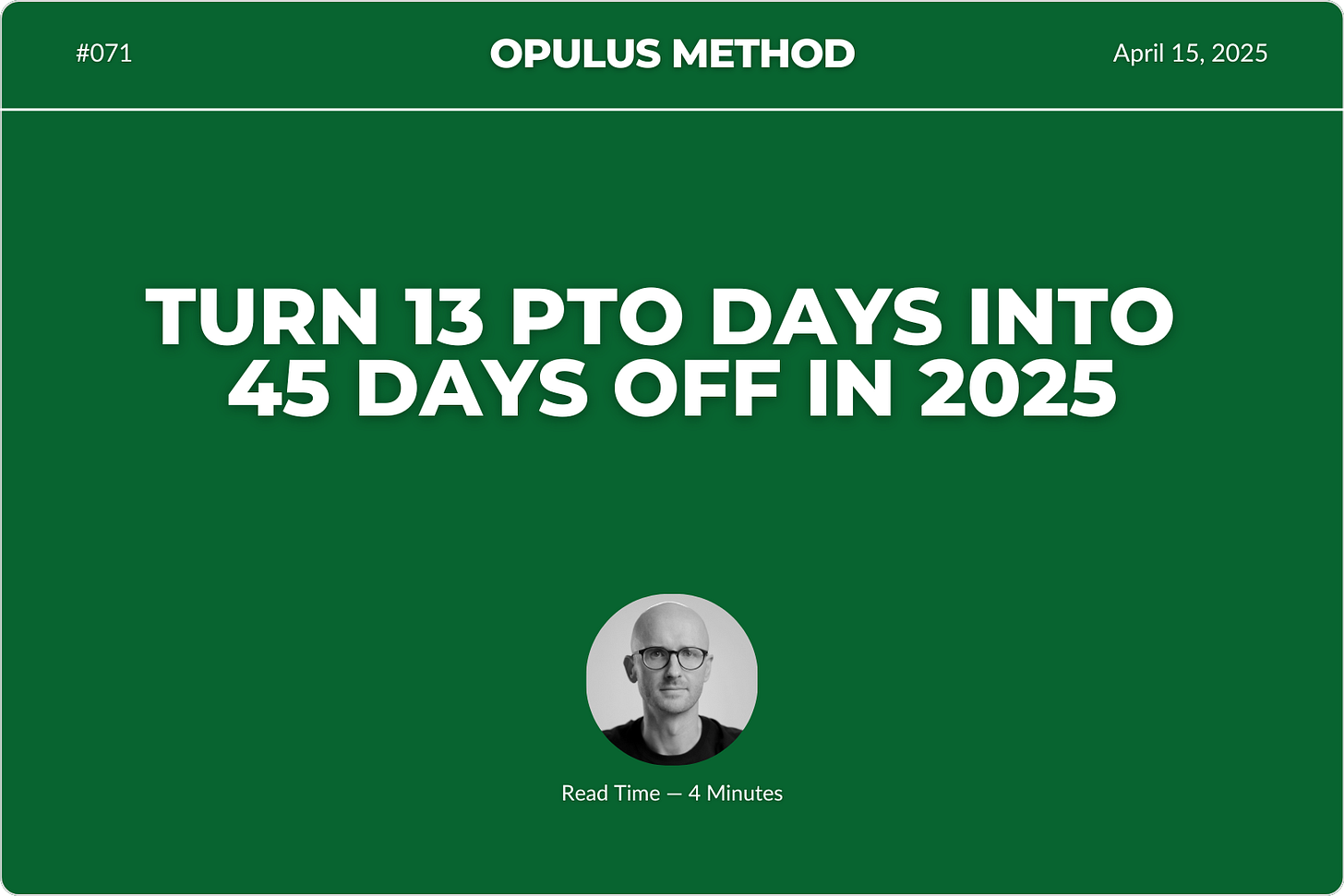Turn 13 PTO days into 45 days off in 2025
Without sacrificing your career momentum or reputation.
Most people waste their PTO days on random Fridays throughout the year.
But what if you could strategically turn your standard 13 PTO days into 45 total days off?
This isn't about taking more time off work—it's about redesigning how you use the time you already have.
The window to plan your 2025 strategic breaks is closing fast. The smart vacation periods need to be planned now.
Here's what we'll cover today:
The framework that transforms limited PTO into maximum freedom
Season-by-season strategies to triple your time off
How to leverage remote work for even more flexibility
Key booking windows you need to target immediately
Let's get into it ↓
The Framework: Why Strategic PTO Planning Works
The average professional leaves 5-7 PTO days unused each year. That's like throwing away a paycheck.
But the real problem isn't just unused days—it's inefficient use of the days you do take.
The secret isn't having unlimited PTO. It's about strategic placement around existing holidays and weekends to create extended breaks throughout the year.
This approach gives you:
Longer continuous breaks (crucial for true mental recovery)
Lower travel costs (by avoiding peak booking times)
Less workplace friction (by planning well in advance)
Ready to see how this works in practice?
Spring-Summer Strategy: Front-Loading Your Freedom
Easter Break (April)
Take off: April 17-18 (Thu-Fri)
Get: 4-day weekend using just 2 PTO days
Many schools already have Good Friday off, making this the perfect timing for spring destinations before peak rates hit. Book now—these dates are already filling up at popular destinations.
Memorial Day
Take off: May 23 + May 27
Get: 5 days off using only 2 PTO days
This lines up perfectly with most school year endings—ideal for kicking off summer travel. The beauty here is you're using just 2 days for almost a week off.
Want to know the best part? By planning these breaks now, you'll avoid the last-minute scramble when everyone realizes these optimal windows exist.
Fall Strategy: Making the Most of Q3-Q4
Juneteenth
Option A: Take off June 20 (Friday) = 4-day weekend using 1 PTO day
Option B: Take off June 16-18 + 20 = 9 days off using 4 PTO days
This relatively new federal holiday creates a perfect opportunity that most haven't yet incorporated into their planning. Option B gives you a massive 9-day break for half a week's PTO.
4th of July
Holiday falls on Friday (automatic 3-day weekend)
Take off: July 7 (Monday) = 4 days off using 1 PTO day
Perfect for quick summer getaways when everyone's in good spirits. One strategic day extends your break by 33%.
Labor Day
August 30 - September 1 → Built-in 3-day weekend (no PTO needed)
Ideal for that final summer trip, beating the back-to-school rush, and taking advantage of off-peak travel rates.
Think about it: we're halfway through the year and you've only used 6-9 PTO days while enjoying multiple extended breaks.
End-Year Escape Plan
This is where the real magic happens.
Thanksgiving
Take off: Nov 24-26 (Mon-Wed)
Get: 9 days off using just 3 PTO days
Kids are already off Wednesday through Friday. This is perfect for family trips before holiday rates spike. Book flights for this period by July for the best rates.
Holiday Break
Take off: Dec 22-23 + Dec 26
Get: 9 days off using only 3 PTO days
This aligns with school breaks (Dec 22 - Jan 2). The office is typically quiet anyway, making it ideal for longer trips without the "where are you?" emails.
Have you noticed the pattern? We're targeting periods where the organization is already slowing down, making your absence less noticeable and more acceptable.
Remote Work Amplification: The Ultimate PTO Hack
Here's where smart professionals take this framework to the next level.
Stack WFH days around these breaks to extend them further—no extra PTO needed.
For example:
Work remotely on April 16 before your Easter break
Work remotely on May 22 before Memorial Day weekend
Work remotely on December 19 before your Holiday break
This creates buffer days where you're technically working but already transitioning into vacation mode. You're productive without the commute and office distractions, and you can start your evening activities earlier.
Remote work days are the perfect bookends to your strategic PTO blocks.
2025 PTO Cheat Sheet
Here's your complete roadmap for maximum time off in 2025:
Easter: 1-2 PTO → 4 days off
Memorial Day: 2 PTO → 5 days off
Juneteenth: 1-4 PTO → 4-9 days off
July 4th: 1 PTO → 4 days off
Labor Day: 0 PTO → 3 days off
Thanksgiving: 3 PTO → 9 days off
Christmas: 3 PTO → 9 days off
That's potentially 43 days off using just 13 PTO days. Triple the return on your time investment.
That’s it.
You don't need unlimited PTO to maximize time off. You just need to plan strategically and book before everyone else.
This framework isn't about gaming the system—it's about designing your life with intention rather than defaulting to what everyone else does.
Start planning the rest of 2025 now. Your future self will thank you.
Thanks for reading.
Whenever you're ready, there are 2 other ways we can help you:
30-Day Strategy Sprint: Got a specific financial challenge holding you back? In just 30 days, we'll tackle 1-3 of your biggest money roadblocks and hand you a personalized action plan. Perfect if you want expert guidance without a long-term commitment. Limited spots available.
Ongoing Wealth Partnership: We'll work with you month after month to slash your taxes, find hidden income opportunities, and build lasting wealth. You set the life goals. We handle the financial strategy to get you there faster.
Opulus, LLC (“Opulus”) is a registered investment advisor in Pennsylvania and other jurisdictions where exempted. Registration as an investment advisor does not imply any specific level of skill or training.
The content of this newsletter is for informational purposes only and does not constitute financial, tax, legal, or accounting advice. It is not an offer or solicitation to buy or sell any securities or investments, nor does it endorse any specific company, security, or investment strategy. Readers should not rely on this content as the sole basis for any investment or financial decisions.
Past performance is not indicative of future results. Investing involves risks, including the potential loss of principal. There is no guarantee that any investment strategies discussed will result in profits or avoid losses.
All information is provided "as-is" without any warranties, express or implied. Opulus does not warrant the accuracy, completeness, or reliability of the information presented. Opinions expressed are those of the authors, Ryan Greiser and Francis Walsh, and are subject to change without notice.
Opulus is not responsible for any errors or omissions, nor for any direct, indirect, or consequential damages resulting from the use or reliance on this information. Use of the content is at your own risk. This content is not intended as an offer or solicitation in any jurisdiction where such an offer or solicitation would be illegal.





